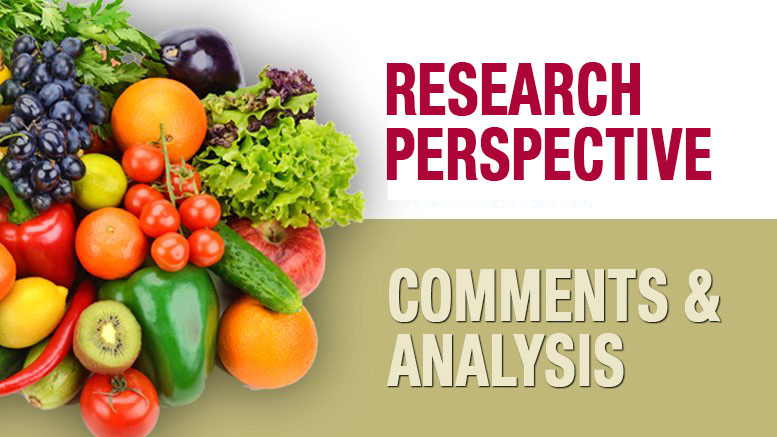Meet the New Food Connected Consumer
December 1, 2018 | 8 min to read
The article, written by Susie Fogelson, explores the emergence of the **Food Connected Consumer (FCC)**, now representing nearly **two-thirds of the U.S. population**. These consumers prioritize positive food experiences and transparency, expressing significant concern about the origins of their food. They spend about **$835 billion annually**, seek diverse global flavors, and are eager to adapt recipes. However, questions remain about their actual purchasing behaviors compared to expressed values, highlighting a need for further research to bridge this gap.

Originally printed in the December 2018 issue of Produce Business.
By Susie Folgelson
Read Jim Prevor’s Commentary below
Does it feel like most people you meet these days are ‘foodies’ to some degree? We know, everybody eats. And while not everybody cooks, one can confidently assume that given the choice, a positive food experience is preferred over a blah, or even negative one.
Now, that alone doesn’t make one a foodie. But consider the notion that as someone chooses more and more of these positive food experiences (from recipes, to well-reviewed restaurants, to clean labels, to plant-based proteins, to programmed content … you get the idea) they come closer and closer to being at least a foodie relative. Technology has assisted the democratization of food, and our relationship to it has changed. We’re all critics and content producers, we have access to techniques and flavors from around the entire globe, and we all have that friend on social media.
At F&Co., we set out to gain a better understanding of this new foodie, a group we call the Food Connected Consumer (FCC). Foodies were a relatively small group, but 62 percent of the US, that’s roughly two-thirds of the population, are Food Connected.
Research, commissioned by F&Co., was conducted by Jump Rope Innovation via an online survey; a general sample of consumers was screened to meet the following criteria: Age 18 – 54; Have at least some involvement with food decisions and behaviors (purchasing, cooking, influencing out-of-home eating decisions). This alone wouldn’t place one in the Food Connected Consumer column; qualified respondents answered a variety of questions aimed at helping us define Food Connected Consumers and, subsequently, profile this group multi-dimensionally.
Our access to information has changed what we’ve come to expect from brands across verticals, and this demand for transparency plays out in FCCs in a somewhat expected way.
The nearly two-thirds of Americans who are Food Connected Consumers spend $835 billion annually. They define themselves as having an “average or above” level of passion for food, and the content they consume reflects this. Ninety-one percent of FCCs look online for recipes and cooking ideas, and 56 percent watch food shows on TV/Netflix/YouTube and other media. They are a well-informed group when it comes to their interests, however, when asked for a “go to” source for food info and inspiration—with options ranging from social media, to friends (word of mouth), to TV, newspapers, and magazines—no single source received much above 20% of votes. For brands trying to reach FCCs, there are a couple of implications: 1. There is an opportunity to tell a truly robust story, utilizing multiple platforms, formats, and channels, all working together to build the right narrative; 2. Content planning requires a proper mix of media for brand stories to truly resonate.
Our access to information has changed what we’ve come to expect from brands across verticals, and this demand for transparency plays out in FCCs in a somewhat expected way, given their media consumption around one of their favorite subjects.
100 percent of FCCs are concerned about where their food comes from—and this is about more than blockchain tracking. They care about who the people (companies) are behind the food, what they stand for and how they’re making the world a better place, because they care about where they spend their money. Of course, FCCs are mindful about what they put into their bodies, many seek to optimize health through diet.
75 percent of FCC say they “doctor or change recipes to suit their needs, (sure, some of this may attributed to flavor preference and ingredient availability). Knowing what kind of range a food product has—how and where it can be used as a substitute—becomes of greater importance to FCCs, and in-turn, brands selling those products (in some cases, even adjacent brands). Food Connected Consumers’ passion drives a hunger for new experiences, which leads to exploration.
67 percent of FCC consider themselves food explorers. Global Flavors has been a growing food trend over the past several years with tastes evolving to embrace Korean, Filipino, and Vietnamese cuisines.The FCC palate craves a more diverse range of flavor brands shouldn’t be afraid to serve it up.
The overall implication for any brand trying to resonate and engage with FCCs: Tell the food’s story. Tell the full story. Tell us where the food came from, how was it made, how it got into our hands; moreover, tell us why it’s a better option for the world than a competitor’s product sitting next to it. Tell us why it was created in the first place, why the world needed it. FCCs are aware of the interconnected nature of this planet, the environmental and social issues that have a strong impact on food. The full story should start somewhere around: ‘wanting to make something better, for consumers, for communities, for the planet’; and end at ‘delicious.’

Fogelson & Co (F&Co), Brooklyn, NY, is a boutique strategy and branding firm that helps companies, private equity and innovators in the food, hospitality and beverage industries develop compelling and sustainable food stories and a differentiated brand identity. F&Co was founded by Susie Fogelson, who is well-known for leading marketing and strategy for the Food Network and Cooking Channel.

Jump Rope Innovation (JRI), Hillsdale, NJ, is a premier trends and innovation consultancy that partners with large global packaged goods brands and small start-ups alike, in service of smart innovation. JRI uses a hands-on, experiential approach to uncover the “what” and the “why” of consumer and category trends, and to bring these learnings to life through break-through platform identification, idea generation and concept development.
Will Technology Fuel Food Connections?
By Jim Prevor
British politician William Vernon Harcourt declared, “We are all socialists now.” Nobel Prize winning economist Milton Friedman declared, “We are all Keynesians now.” Peter Mandelson, former director of media relations for the British Labour party, declared, “We are all Thatcherites now.”
Today, Susie Fogelson of Fogelson & Co., declares, “We are all Food Connected Consumers.”
Well, maybe not quite ALL, but quite a lot. According to Fogelson’s research, Food Connected Consumers represent two-thirds of the relevant market. It is a little hard to understand what characteristics exactly distinguish the Food Connected Consumer from what we used to call a Foodie, and many of the traits identified by her could be a result of technological change more than any passion for food.
Back in the 1960s, my mother used to read Good Housekeeping and similar magazines in order to find recipes and cooking ideas. Did that make her a foodie? I don’t think so.
Equally, the fact that people “look online for recipes and cooking ideas” or that 56 percent of them watch food shows on TV, Netflix or YouTube may just tell us more about how people get information today than about their deep food-related passion. If you want a recipe today, a lot of people whip out their iPad, because one can search for recipes online more efficiently than scrambling through old magazines.
It is also hard to judge the significance of many of these things, as there is no point of comparison. When 75 percent of Food Connected Consumers say they “doctor or change recipes to suit their needs,” we neither know historically whether this is a change — my grandmother did this — and we don’t even know to what degree non-Food Connected Consumers do this as they were not studied!
It is also hard to know what significance to give this study as the research was not adjusted to mirror the U.S. population. Ideally, you want to make sure that the survey respondents mirror the country as a whole ethnically, religiously, income-wise and on other variables.
When it comes to the desire expressed by Food Connected Consumers to know where their food comes from — a desire alleged to be so strong it is expressed by an almost unheard of 100 percent of FCC respondents — the question is whether this is just an expression of aspirational desire — a reflection of a belief they should want to know this — or whether in some tangible and important way, it is changing buying habits.
Though it is very possible that people say, “They care about who the people (companies) are behind the food, what they stand for and how they’re making the world a better place, because they care about where they spend their money,” it is hard to correlate this with any known spending pattern. Walmart is, by far, the largest food retailer in America; Aldi is the fastest-growing; and Amazon is the leader in online. The first two are discounters, and there is an article in the paper every day alleging tough labor practices at Amazon.
When people say things that are so divorced from what they are actually doing, the job of the researcher is to ask why this is so.
Lots more research needs to be done here, but, as best as we can see, the problem is that asking people whether they care about “making the world a better place” is not a neutral question. They can either say, ‘yes,’ and be a good person and responsible citizen, or they can say, ‘no,’ they are more interested in saving money on their groceries so they can go on a vacation to the Caribbean this year but be seen as a selfish, shallow human being.
Telling the story is relatively easy, but knowing how to motivate consumers to invest their valuable time in learning the story before buying a lemon for 49 cents is going to require a lot more research.
It is almost certainly true that people are increasingly “food explorers,” but we would guess that this is less a function of any great change in people’s attitudes than it is a change in the environment and thus the opportunities available to people. When the Chinese, Italian or eastern European Jewish immigrants came to America — and they opened Chinese restaurants, Italian restaurants and Jewish delis in major urban areas — the restaurants adapted their dishes to mainstream American taste profiles and people enjoyed the food.
The difference now is that ethnic diversity is broader, with more people from more diverse places, and that immigrants have moved more into the center of the country. Whereas boats laden with immigrants had to land in harbor towns, a plane today can land in Orlando or Atlanta as easily as New York or Miami. Of course, the Internet, TV, etc., have all served to expose consumers to many types of foods, and services such as Amazon have made many foods available all across the country.
It is probably true that if one can get a consumer to pay attention to your whole product story, this will sway many consumers to buy.
What is left unexplored is how much time consumers will devote to evaluating relatively inexpensive products, such as most foods. Already the Internet is filled with lots of information, and very few consumers bother to access it. Telling the story is relatively easy, but knowing how to motivate consumers to invest their valuable time in learning the story before buying a lemon for 49 cents is going to require a lot more research.

